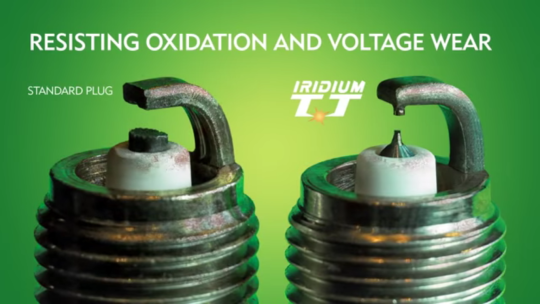Whether you’re an automotive DIY-er or a DIFM-er (that’s Do-It-For-Me), it’s always good to have some insight on the parts you need – or think you might need – to replace.
To celebrate DENSO’s new Iridium TT Spark Plug HD, we caught up with DENSO’s James Miyamoto, in powertrain product management, to get some insight into what spark plugs are, and when spark plugs are ready for a change-out.
What Is a Spark Plug?
A spark plug is a device that is located in the cylinder head of a gasoline powered engine. It facilitates a spark that ignites the air/fuel mixture in the cylinder that creates combustion.

What Does a Spark Plug Do?
The spark plug converts electrical energy from the ignition system into a spark that ignites the air-and-fuel mixture inside the cylinder to create an explosion. That explosion then thrusts the piston towards the bottom of the cylinder, which pushes a connecting rod, that turns the crankshaft, turns the flywheel, turns the clutch/converter, turns gears in the transmission, turns the drive axles, then finally turns the wheels, allowing the car to move.
How Has the Spark Plug Changed Over the Years?
The spark plug was invented In 1860 by Étienne Lenoir, who invented the first internal combustion piston engine. The basic plug underwent many design variations, such as increasing the number of electrodes, recessing or projecting the center electrode, physical changes in size, creating a groove in the center or ground electrode, just to name a few.
The evolution of the spark plug rapidly accelerated with the introduction of using precious metals in the mid-1980s. Platinum was introduced to increase the service interval, due to its resistance to wear and oxidation. Then Iridium was introduced in the 2000’s, which was even more durable and also enabled manufacturers to create smaller diameter center electrodes which help to facilitate a more intense spark.
The latest technology incorporates small diameter center and ground electrode designs using Iridium and Platinum called the “Needle-to-Needle” or “Twin-Tip” configuration. These plugs can last over 100,000 miles while maintaining peak performance through the life of the spark plug.

Why Does a Spark Plug Need Attention?
The spark plug gap widens due to electric discharge wear and oxidation from extreme heat and pressures that happen in the combustion cycle. The widened gap essentially creates more resistance to creating a spark. When the gap increases too much, intermittent (small) misfires occur. This results in a less efficient burn per combustion cycle, which leads to overall decrease in engine performance such as loss in power, torque, acceleration, and fuel economy. Too much misfire can create major engine damage.
How Often Does a Spark Plug Need to Be Changed?
Depending on what comes originally in the vehicle, spark plugs can last from 30,000 miles to over 100,000 miles. Auto manufacturers started to equip vehicles with Iridium spark plugs, which can last over 100,000 miles.
Telltale Signs that Your Spark Plugs Need Changing:
- Your engine has a rough idle
- You are having trouble starting your car
- Your engine misfires
- Engine surging or hesitates
- You are getting poor mileage
- You experience a lack of acceleration.
***
DENSO has recently introduced its Iridium TT Spark Plug, which can last more than 100,000 miles. For info on where to pick ‘em up, head to our pals at AutoZone, Advance Auto Parts, or look up locations in your area.
If you’re the DIFM type, and need to book spark plug replacement with a quality mechanic near you, check out Openbay, where you can compare, book and pay for auto repair and maintenance all in one spot.
Drive safely!
